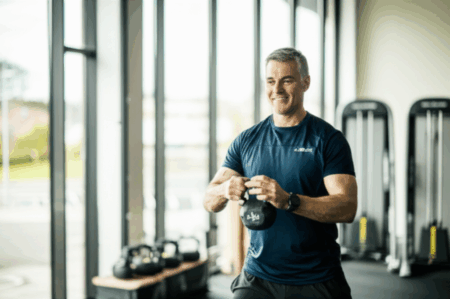We all know exercise is important, but fitting it into a busy schedule can feel impossible. What if I told you that just five minutes of daily exercise could significantly improve your fitness and mental health? A recent study has revealed the surprising power of short, consistent workouts, proving that even the smallest efforts can lead to big results.
The Science Behind the Five-Minute Miracle
Researchers at Edith Cowan University (ECU) in Australia have discovered that a mere five minutes of strength training each day can yield remarkable benefits for both physical and mental well-being. The study, published in the European Journal of Applied Physiology, involved a group of sedentary adults who performed a simple bodyweight exercise routine daily for four weeks.
The Workout
The five-minute workout consisted of the following exercises, performed for 10 repetitions each:
- Chair Squats: Stand in front of a chair and lower yourself down as if you’re going to sit, then stand back up.
- Wall Push-ups: Place your hands on a wall and perform a push-up, bending your elbows and leaning towards the wall.
- Chair Reclines: Sit in a chair and lean back slightly, engaging your core muscles.
- Heel Drops: Stand with your heels hanging off the edge of a step or stable surface, then slowly lower your heels down as far as possible.
The exercises focused on eccentric movements, which involve lengthening the muscles under tension. For example, during the chair squat, participants were encouraged to slowly lower themselves down, focusing on the lengthening of the thigh muscles.
The Results
After just four weeks, the participants experienced significant improvements in several key areas:
- Increased Muscle Strength: The bodyweight exercises effectively built strength in the participants’ muscles.
- Improved Strength Endurance: Participants were able to perform the exercises for longer periods without fatigue.
- Enhanced Flexibility: The stretching and lengthening movements contributed to greater flexibility.
- Better Cardiovascular Health: The study observed a small drop in average post-exercise heart rate, indicating improved cardiovascular function.
- Boosted Mental Health: Participants reported feeling happier and more positive after completing the daily workouts.
An impressive 83 percent of participants continued with the exercises even after the study concluded, demonstrating the sustainability of this simple routine.
Why Five Minutes is Enough
You might be skeptical that five minutes of exercise can truly make a difference. However, several factors contribute to the effectiveness of this approach:
- Consistency: The key to success is performing the workout daily. Even a short burst of exercise can have a cumulative effect over time.
- Intensity: While the exercises themselves are not overly strenuous, they should be performed with focus and intention, engaging the muscles and pushing yourself to a comfortable limit.
- Accessibility: The exercises require no equipment and can be done anywhere, making it easy to fit them into your daily routine.
- Eccentric Training: Focusing on eccentric movements maximizes muscle activation and promotes strength gains.
The Power of Exercise Snacking
The five-minute workout aligns with the concept of “exercise snacking,” which involves breaking up physical activity into small, manageable chunks throughout the day. Exercise snacking can be a particularly effective strategy for those who struggle to find time for longer workouts.
A study by the University of Essex and University of Suffolk found that just 16 minutes of bodyweight exercises, spread across an eight-hour workday, could mitigate the negative effects of prolonged sitting. Participants experienced improved leg strength and balance from this minimalist exercise plan.
How to Incorporate Exercise Snacks
Here are some easy ways to incorporate exercise snacks into your daily routine:
- Take the stairs: Instead of using the elevator, climb a few flights of stairs.
- Walk during breaks: Get up from your desk and walk around for a few minutes every hour.
- Do squats while waiting: Perform a few squats while waiting for the kettle to boil or the microwave to finish.
- Stretch at your desk: Take a few minutes to stretch your arms, legs, and back.
- Dance to your favorite song: Put on some music and dance for a few minutes to get your heart rate up.
High-Intensity Interval Training (HIIT)
Another effective way to maximize a short workout is through High-Intensity Interval Training (HIIT). HIIT involves short bursts of intense exercise followed by brief periods of rest or low-intensity exercise.
A Tabata workout, for example, is a four-minute HIIT routine consisting of 20 seconds of intense effort followed by 10 seconds of rest, repeated eight times. Studies have shown that HIIT can significantly improve both anaerobic and aerobic fitness.
Benefits of HIIT
HIIT offers a wide range of benefits, including:
- Improved Cardiovascular Health: HIIT can lower blood pressure, improve blood sugar control, and reduce the risk of heart disease.
- Increased Metabolism: HIIT can boost your metabolism and help you burn more calories throughout the day.
- Enhanced Muscle Strength: HIIT can stimulate muscle growth and improve strength.
- Weight Loss: HIIT can be an effective way to lose weight and reduce body fat.
- Time Efficiency: HIIT workouts are short and intense, making them ideal for busy individuals.
The Mental Health Boost
The benefits of exercise extend far beyond the physical realm. Studies have shown that even short bursts of physical activity can have a significant impact on mental well-being.
Exercise triggers the release of endorphins, which have mood-boosting and stress-reducing effects. It can also improve cognitive function, sharpen focus, and enhance mental clarity.
Exercise for Mental Wellness
Here are some ways exercise can benefit your mental health:
- Reduces Stress and Anxiety: Exercise can help to lower levels of stress hormones like cortisol and adrenaline.
- Improves Mood: Exercise can increase levels of mood-boosting neurotransmitters like serotonin and dopamine.
- Boosts Self-Esteem: Achieving fitness goals can improve self-confidence and body image.
- Enhances Cognitive Function: Exercise can improve memory, attention, and overall cognitive performance.
- Promotes Better Sleep: Regular exercise can help to regulate sleep patterns and improve sleep quality.
Making it a Habit
The key to reaping the benefits of the five-minute workout is to make it a consistent habit. Here are some tips for building exercise into your daily routine:
- Schedule it: Set aside a specific time each day for your workout, just as you would for any other important appointment.
- Make it convenient: Choose a time and location that are easily accessible and convenient for you.
- Start small: If you’re new to exercise, start with just a few minutes and gradually increase the duration as you get fitter.
- Find an activity you enjoy: Choose exercises that you find enjoyable and motivating.
- Track your progress: Keep a record of your workouts to monitor your progress and stay motivated.
- Reward yourself: Celebrate your achievements with non-food rewards, such as a new workout outfit or a relaxing massage.
- Be patient: It takes time to build a habit, so don’t get discouraged if you miss a day or two. Just get back on track as soon as possible.
Beyond the Five Minutes
While a five-minute workout can be a great starting point, it’s important to remember that more exercise generally leads to greater benefits. As you get fitter, consider gradually increasing the duration or intensity of your workouts.
The recommended amount of exercise for adults is at least 150 minutes of moderate-intensity or 75 minutes of vigorous-intensity aerobic activity per week, along with muscle-strengthening activities on two or more days per week.
A Well-Rounded Fitness Plan
A comprehensive fitness plan should include a variety of activities, such as:
- Aerobic exercise: Activities that get your heart pumping, such as walking, running, swimming, or cycling.
- Strength training: Exercises that build muscle, such as lifting weights, using resistance bands, or doing bodyweight exercises.
- Flexibility training: Stretches that improve your range of motion and reduce the risk of injury.
- Balance training: Exercises that improve your stability and coordination.
Is a Five-Minute Workout Enough to Build Muscle?
While a five-minute workout might not be enough to pack on significant muscle mass, it can still contribute to muscle growth, especially for individuals who are new to exercise.
“The benefit is going to be greater for individuals who tend to be more sedentary,” says Jennifer Hurrell, a physical therapist and clinical associate professor at Bryant University.
To maximize muscle growth with short workouts, focus on compound exercises that work multiple muscle groups at once, such as squats, push-ups, and lunges. You can also try increasing the intensity by adding resistance or performing the exercises at a slower pace.
Getting Started
Ready to experience the transformative power of the five-minute workout? Here’s how to get started:
- Choose your exercises: Select a few simple bodyweight exercises that you enjoy and can perform safely.
- Set a timer: Set a timer for five minutes.
- Warm-up: Do a few minutes of light cardio, such as jogging in place or jumping jacks.
- Perform the exercises: Do each exercise for 30-60 seconds, focusing on proper form.
- Cool-down: Stretch your muscles for a few minutes.
- Repeat daily: Make it a habit to do your five-minute workout every day.
The Bottom Line
Don’t let a lack of time be an excuse to skip exercise altogether. A five-minute workout can be a surprisingly effective way to improve your fitness and mental health. By incorporating short bursts of physical activity into your daily routine, you can reap the many benefits of exercise without sacrificing a lot of time. So, what are you waiting for? Get moving and experience the power of five minutes!







